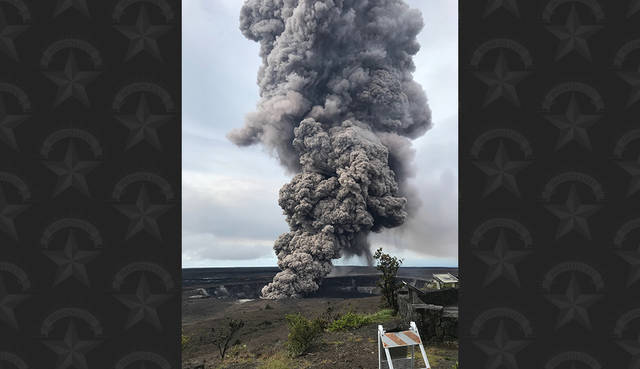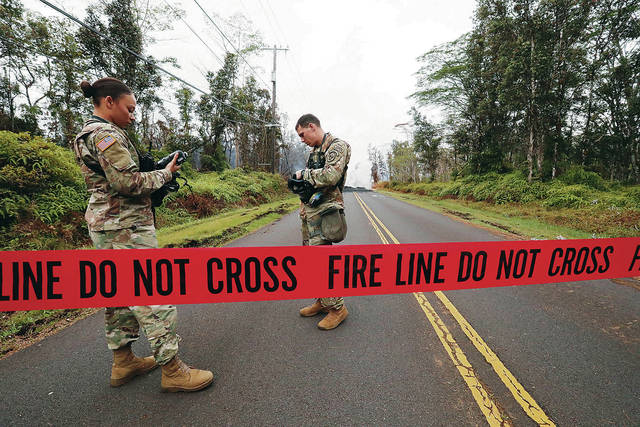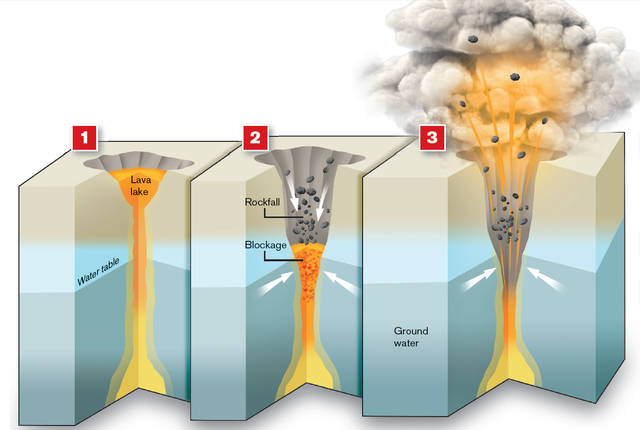Disaster may be brewing at Kilauea’s summit

COURTESY U.S. GEOLOGICAL SURVEY
A huge ash cloud rises from Overlook Crater at Kilauea’s summit on Wednesday, triggered by a rockfall along the steep walls of the crater.

CINDY ELLEN RUSSELL / CRUSSELL@STARADVERTISER.COM
U.S. Army National Guard Sgt. Maryann Marr, left, and Sgt. Milo Kalama prepare to escort journalists at Leilani Ave. in Pahoa, where fissure 13 erupted on Wednesday.

ILLUSTRATION BY KIP AOKI / KAOKI@STARADVERTISER.COM
Scientists at the Hawaiian Volcano Observatory say a steady drop in the Halemaumau lava lake at Kilauea volcano’s summit crater indicates that an explosive eruption may occur with little warning. From its peak on May 2 to the most recent measurement on May 6, the lava lake surface has dropped more than 656 feet, or about 2 yards per hour. Hot rocks collapse, reaching groundwater and creating steam trapped in the rubble. Pressure from steam buildup leads to an explosion.



Six days into a volcanic eruption that has already forced the evacuation of an estimated 1,800 people from subdivisions in Lower Puna, scientists raised the possibility of an explosive new hazard nearly 30 miles away at the Kilauea summit.
Scientists at the Hawaiian Volcano Observatory announced the lava lake at Halemaumau has drained off to the point that the magma may soon drop below the level of the water table, which might lead to steam-powered explosions that could blast boulders as large as two yards wide more than a half-mile from the crater.
Those explosions could occur with little warning, and could launch pebble-sized rocks as far as “several miles,” according to the U.S. Geological Survey scientists. The blasts could also toss huge ash plumes into the air, spreading ash as far as Hakalau in North Hilo or Waiohinu in Kau, experts said.
The majority of Hawai‘i Volcanoes National Park will close Friday due to the possibility of an explosive steam event and ash fall.
> Star-Advertiser Kilauea volcano coverage: https://808ne.ws/2FIMk5c Opens in a new tab
> Hawaii-born MLB player Kolten Wong joins list of GoFundMe fundraisers: https://808ne.ws/2JXUg5h Opens in a new tab
> Science explains Kilauea https://808ne.ws/2wmIuzj Opens in a new tab
> Lava flow at Leilani Estates in Pahoa: https://808ne.ws/2rq0292 Opens in a new tab
> Photos from Leilani Estates as lava advances: https://808ne.ws/2whJ2GZ Opens in a new tab
> Residents in Nanawale Estates keep an eye on Pele: https://808ne.ws/2JTo8jm Opens in a new tab
Don't miss out on what's happening!
Stay in touch with breaking news, as it happens, conveniently in your email inbox. It's FREE!
RELATED VIDEO
> Leilani Estates resident talks about not evacuating Opens in a new tab
> AP: Lava flow oozes onto Hawaii pavement Opens in a new tab
> Hawaii island residents monitor Kilauea flow Opens in a new tab
> Aerial footage of lava flowing into Leilani Estates on May 6 Opens in a new tab
> Leilani Estates home goes up in flames after lava strikes Opens in a new tab
> East Hawaii residents brace as 6.9 quake hits Opens in a new tab
> Crack opens in road, lava flows in Leilani Estates Opens in a new tab
> Puu Oo vent empties Opens in a new tab
Kilauea’s Lower East Rift Zone burst open its 15th vent Wednesday afternoon in an area near Leilani Estates, further damaging Pohoiki Road, according to scientists and county officials. That vent oozed out lava for about 20 yards, and then stopped.
Civil Defense officials also announced Wednesday that police have evacuated 10 homes on Alaili Road west of Highway 130 because of hazards posed by steaming cracks in the ground.
The eruption in and around Leilani has now covered more than 116 acres with lava, and destroyed 36 buildings, according to Hawaii County Civil Defense officials. The county reported 272 people were staying at a shelter at the Pahoa Community Center, and 15 were staying at a shelter in Keaau. Many hundreds more are staying with friends or family.
Scientists say there is still more magma stored underground that could continue to feed the eruption.
The lava lake at the summit has been draining at a steady rate, and at about 8:30 a.m. Wednesday the system demonstrated a bit of its explosive potential when it launched an impressive cloud of ash and debris into the air. The tradewinds then blew the dust plume to the southwest, scientists said.
Hawaiian Volcanoes Observatory Scientist-in-Charge Christina Neal said scientists believe a small earthquake near the summit triggered a large rockfall into the crater that triggered that explosion from the surface of the remaining lava lake.
“I think it’s our best estimation that this is the first of perhaps more events like that to come,” Neal said.
USGS Geologist Don Swanson said the risk of explosions stems from lava draining out of the conduit that contains lava, causing the level of the lava to drain below the water table. Water then flows into that super-heated conduit, boils and produces steam.
That steam likely will simply cook off unless it is blocked by rocks falling from the conduit walls that form a dam, he said. If that happens — and rock falls are common — pressure from the steam will build until it finally bursts out in an explosion, carrying rock and debris with it.
“If you are near the crater, within half a mile or so, you would be subject to bombardment by ballistic blocks weighing as much as 10 or 12 tons,” Swanson said. He said scientists believe that if the lava level continues to drop, it could drop below the water table by mid-May.
Jim Kauahikaua, a USGS geophysicist, said an eruption in 1924 followed a similar pattern, and “it blew out the conduit, it ended up doubling the diameter of Halemaumau, and it was a pretty impressive set of 2-1/2 weeks of explosions.”
“We have issued a notice that we see the same conditions starting to occur — or they currently are occurring — and if it follows the 1924 example, there would be a possibility that explosions, steam blast explosions may occur within a few days,” he said.
When asked if that could pose hazards for residents of Volcano Village several miles away, Kauahikaua replied that “depends on the magnitude of the explosions.”
Swanson said scientists cannot tell exactly when the conduit will empty of magma below the water table, or when that development could cause an explosion.
“We suspect that it’s quite a rapid process, but we really don’t know for certain, so there have to be uncertainties involved with all of the estimates that we’ve made,” he said.
The crater is surrounded by Hawai‘i Volcanoes National Park. Neal said USGS scientists are in close contact with park management and will keep them informed about conditions under the summit that might pose a risk to park visitors.
Jessica Ferracane, spokeswoman for the national park, issued a news release Wednesday evening, saying that because of “southerly wind patterns forecast for Friday, the majority of the park will be closed Friday until further notice. We will reopen when it is safe to do so.”



